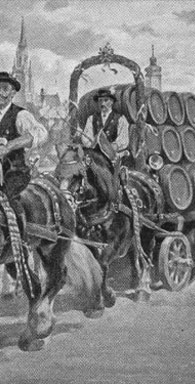Chapter 5 About the Oktoberfest
The Munich Oktoberfest is a one-of-a-kind with a unique history. Starting as a royal wedding, it has become an event of international renown, yet one at which traditions still play an important role: at the beginning of each Oktoberfest, the tent landlords come to the Theresienwiese in procession, as do hundreds of traditionally-clad Bavarians; then there’s the ceremonial tapping of the keg, gun salutes, and lots of other annual elements.
At the same time, the Oktoberfest has not stood still, and the people behind it know how to keep up with the times: historical carousels are set up next to towering, state-of-the-art white-knuckle rides; traditional Bavarian fayre is sold alongside of-the-moment culinary creations; sentimental instrumentals are played while rock and pop songs are belted out.
So special and so unique is the Oktoberfest atmosphere that guests come from everywhere in Germany and around the world to experience it. And Munich is as happy to welcome new guests as it is to say “Hello again!” to those returning: that’s Bavarian hospitality for you! Every year, a new chapter is added to the exciting and eventful annals of the Munich Oktoberfest.
The History of the Oktoberfest
The first Oktoberfest
The first ever Oktoberfest took place on 17th October 1810 – and was, in fact, a wedding. When Crown Prince Ludwig of Bavaria married Princess Therese or Saxony-Hildburghausen, the festivities in Munich went on for five days: there were parades and performances, there was music, food, and drink. The pleasure wasn’t just reserved for the nobility, either, with a party put on for the general population, too.
To conclude proceedings, a horse race was held on the suggestion of banker and cavalry major Andreas von Dall’armi on what is today the Theresienwiese (the fields were named for the bride, Therese). The populace was so delighted by the festivities that it was soon decided to make them an annual tradition.
Since then, the Oktoberfest has been a yearly occurrence, only rarely prevented from taking place by war or epidemics. In the first years, the horse races and agricultural shows remained its centrepieces, but as time went on, the event increasingly became the internationally renowned festival which it is today.

The world’s largest beer festival
The Munich Oktoberfest is officially the world’s largest Volksfest, a typically German hybrid of a beer festival and travelling funfair. It takes place on an area measuring 34.5 hectares (except for every fourth year, when it must share the space with an agricultural show) and welcomes between 5.5 and 6.5 million visitors every year. Guests come from Munich and Bavaria, from all over Germany, from neighbouring European countries, and from even further afield. The Oktoberfest is famous enough as far away as Asia, the USA, and Australia for travel agents there to offer special tours to Munich.
Over 500 stallholders, fairground rides and tent landlords set up at the Oktoberfest every year, employing around 13,000 workers during the two weeks. With over 7 million litre tankards filled and sold annually, the amount of beer served is probably the highest worldwide. Despite the international interest in and influx to the Oktoberfest, it has nevertheless lost nothing of its traditional Bavarian character.
The “Oide Wiesn”
First held in 2010 to celebrate the 200th anniversary of the first ever Oktoberfest, “Oide Wiesn” is Bavarian dialect for “old Wiesn”. Traditional tents and historic fairground rides were put up on a separate area of Theresienwiese – and were so popular that they became an annual fixture. Whether it’s vintage chairoplanes or period boat swings, the rides are not just there to be admired, but ridden too. Then there are tents like Festzelt Tradition, Museumszelt, and Herzkasperl-Festzelt with guaranteed Bavarian music and cultural events. Unlike the rest of the Oktoberfest, the Oide Wiesn charges for entry, but you only need to pay once a day to get a wristband which lets you come and go as you please. Every fourth year, when the Oktoberfest has less space than usual due to the Bavarian Agricultural Show, the Oide Wiesn is absent and represented by Festzelt Tradition until its return.
Oktoberfest trivia
A trained Oktoberfest barman can fill a litre tankard in just 1.5 seconds.
The Flea Circus is an attraction unique to the Oktoberfest; its team of around 60 fleas are especially popular with younger visitors.
Every year, around 7.5 million litres of beer are poured and around 122 oxen consumed.
Postcards put into one of the Theresienwiese letterboxes are franked with a special Oktoberfest stamp.
Albert Einstein is said to have been employed as a fitter during the 1886 or 1896 set-up, screwing lightbulbs into place in Schottenhamel tent.
The famous Wiesn toast – “Ein Prosit der Gemütlichkeit!” – isn’t actually Bavarian, but rather comes from Saxony. The lyric was penned by Chemnitz musician Bernahrd Dittrich and is today a signal for drinkers to take a long, deep sip of their beer.
Lost property at the Oktoberfest Oddities and curiosities found on Theresienwiese in recent years
A wooden sign saying “Sauerkraut”
Lederhosen and dirndl
An electric air-pump
A wheelchair
Crutches
Wedding rings
A dachshund called Wasti
Dentures
A gnome in a Bayern München strip
A fishing rod


